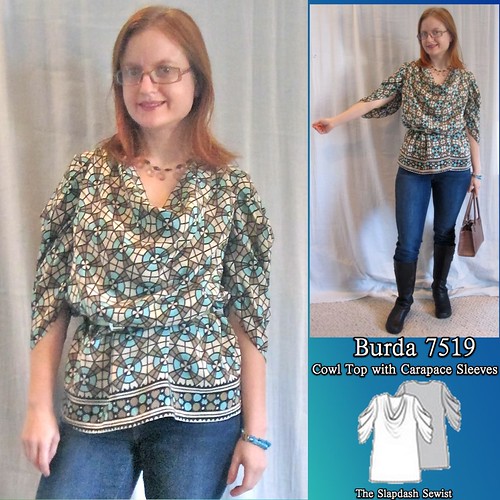
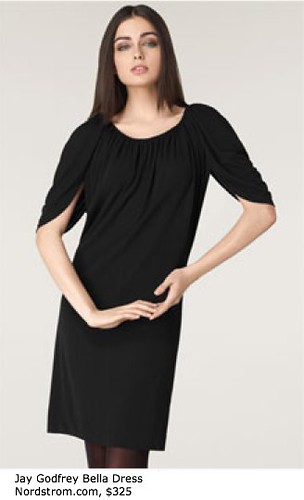
I feel that sleeve variations are one of the more underused ways to make a garment special. I get really sick of making plain, boring sleeves on everything. When I found this top a couple years ago, I was really intrigued by the sleeves. They probably have a boring name like "draped sleeves," but to me they look like beetle wings that appear solid until the insect goes to fly when it appears that its whole body splits open. These sleeves appear solid on the upper side, but when you lift your arms you see they are split to the armscye. So I call them carapace sleeves.
Anyway, I had no idea how they might be done, so when I saw Burda 7519 with that style of sleeve I was thrilled and picked it up. I plan to make a copper-colored silk dress with this pattern, but I wanted to test it out before sewing the dress. The silk fabric for this top was purchased from Fabric Mart many years ago, at least 4 years ago and possibly even 5. The $9.99/yd sticker was still on it; I'm sure it was the most expensive fabric I'd ever bought at the time!
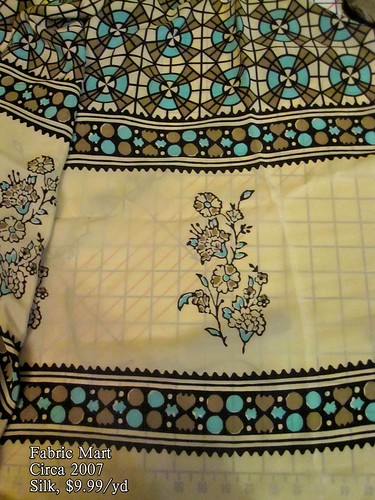
Although I loved it, something kept me from finding the right project for this fabric. Finally I realized the problem was that I loved the main motif, and I loved the border, but the fabric is sort of a "double" border print with the narrow geometric border, then a wide band of beige silk with flowers, and then another narrow geometric border. I just didn't like the flowers at all or their expanse of beige, but somehow I felt that I should reconcile myself to them. After so many years, I acknowledged that I would never like the flowers and it would not be sacrilege to wantonly waste that part of the fabric. Yes, I do have issues.
Anyway, I think this is one of those rare projects where the fabric for the wearable muslin is more expensive than the fabric meant for the final version!
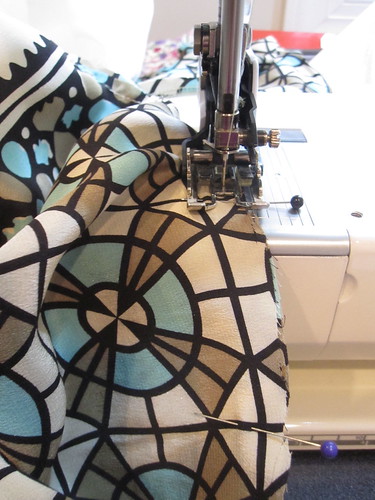
I was testing out several things with this iteration: fit, of course, though I didn't expect it to be an issue as it's an unfitted style; the sleeves; the depth of the cowl; and most crucially, whether the front really has to be cut on the bias. This directional border print really couldn't be cut on the bias, but since it's a flowing silk and the bias isn't needed for fit, as it might be in a narrower-cut garment, I decided to just go ahead and cut on straight grain (the cotton batiste front lining was cut on the bias).
I took a lot of care with pattern matching for this project, and the matches are pretty much spot on (I'm not going to pretend it's perfect, of course!). I pinned at each black line and used the walking foot to ensure even feed of the top and bottom fabric.
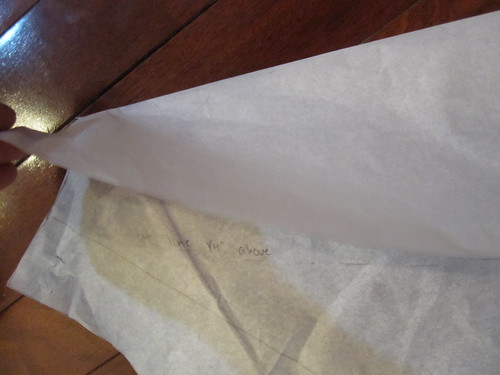
The other thing I changed for this version was to line it.
To cut the front lining, I folded down the self-facing on the pattern and traced where it ended. In cutting the fashion fabric, I added a 1/4 inch seam allowance at the top of the self-facing, and in cutting the lining I added a 1/4 seam allowance above the marked line. I stitched the two pieces together using the serger and pressed well. This creates a neat finish on the inside, and by keeping the front self-facing intact there is no chance of the lining showing at the cowl. When I make the intended dress, which doesn't need to be lined, I will extend the front self facing the entire width of the shoulder and down into the armscye a bit.
I wasn't overly impressed with the construction order and method for this project, so I used my own preferred method for cowl necks.

First, I finished the back neckline by sewing the fashion fabric and back lining right sides together at the neckline, using the serger to trim off the seam allowance, and flipping and pressing. (Well, before that I sewed the CB seam, which I had added to allow for swayback shaping.
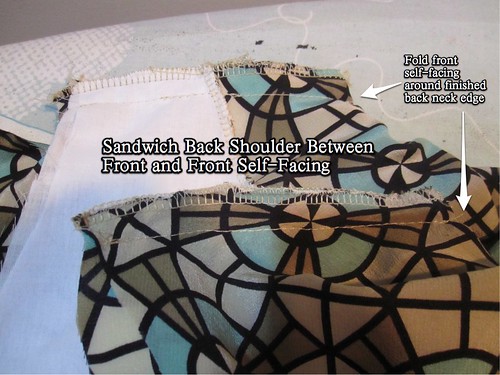
Next, sandwich the back shoulder with the front and its self-facing/lining. The fold line goes at the neckline/inner edge of the back shoulder. Stitch, finish the seam allowances, and turn. The seam allowances will automatically turn toward the front. Press.
Next I sewed the side seams, starting on the fashion fabric and continuing onto the lining.

I treated the fashion fabric and lining as one at the armscye. This method does create a visible seam inside the garment; it is not neatly finished as a fully-lined garment would be. This can be remedied by setting the sleeve only into the fashion fabric, folding down and pressing the lining seam allowance, and then hand stitching the lining to the armscye's seam allowance. I don't go to the trouble unless it's a special garment.

The one review of this pattern that discusses the sleeves mentioned that they are really restrictive. Cutting out the voluminous sleeve pattern, I didn't see how this was possible. The instructions weren't clear on how to install the sleeve. The sleevecap is longer than the armscye so at first I overlapped the finished lower edges of the sleeves. Whoa. I couldn't even pull the sleeve over my arm enough to get the shoulder to my shoulder. How that much fabric can be too tight, I don't understand, but I stopped doubting the reviewer.
I ripped out the sleeves. This time I eased the sleeve cap and abutted the finished edges of the sleeve so they met exactly at the side seam. Huge improvement. The sleeves are no longer tight and uncomfortable. However, I am a little disappointed in them. The distinct tiers of drapes pictured on the envelope don't really show up in my project, though the print could be obscuring their appearance a little. For the intended dress, I might try to figure out how to use the sleeves from Burda 12-2010-102, which are a similar style but a regular "tube" sleeve. It might be tricky because the armscye is cut semi-raglan on that pattern.

After carefully pressing the hem exactly at the border motif, I machine blind hemmed the fashion fabric. The blind hem stitches disappear pretty well into the border print. The lining, which hangs free below the armscye, was hemmed with a regular straight stitch.
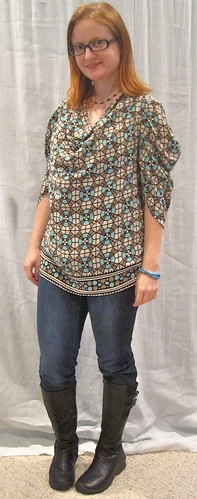
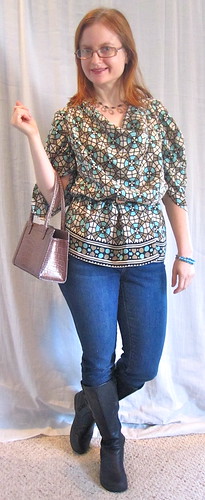
This can *almost* be worn as a true tunic, but the side view is pretty atrocious so I will likely wear it belted at all times. We can wear jeans to work on Fridays. I always feel like I should wear a nicer top to go with them and this really fits the bill.
This is one of those things that I think doesn't look as good in the photos as in real life. It looks more bulky than it really is--the silk is very lightweight and the batiste lining is also light.
I am happy both with the pattern and that I have finally sewn up this special fabric! I normally hem tops at the high hip for the most flattering spot on me, but I wanted a couple longer tops to wear with my jeggings. I cut in between the shirt and tunic length on the pattern.
All photos are here and the pattern review is here.











































































.jpg)
















19 comments:
I like the concept of that sleeve. It would make for great sun coverage in the summer but leave the arm open to air flow.
It's a nice wearable muslin you have there, it looks great with your jeans.
Love this top! I can't wait to see your final version. Also, I can totally see how it would look better in real life - I think in the picture the print is so blod it makes the shirt look heavy, but I can imagine the lightweight silk - it sounds heavenly! I really like the way it looks with the belt.
The fabric looks so soft, I just want to touch it! I really like this floaty style.
I agree that sleeve variations are underrated. And there are too few of them.
I am so jealous that you have time to sew!!! And that it always looks so darn cute!
Love that variation of sleeves! Never knew what it was called.
Those sleeves are so awesome. I love a floaty, bohemian top. I actually really like the photo you posted of it un-belted, though it looks great belted, too. Very pretty fabric, too!
So pretty! I love how you used the print.
I love this. I am on a personal mission to make tops that go with my leggings and jeans, and this would fit right in.
Very, very pretty. The print is gorgeous on you!
Oohh, it's so hard to dream up tops that are dressy looking, comfortable, and are flattering. I think this one is 3 for 3!
That fabric is fantastic, no wonder it took you a long time to cut into it. When you first mentioned your jeggings I didn't think you'd find much to wear with them besides long tops, but I'm loving all the different looks you've come up with!
I agree, the fabric was beautiful, but the fussy flower on a beige background was not. Good call, dumping it. I like the idea of puffy sleeves. It would help balance a pear shaped figure like mine.
I like how it looks belted. Funny that the sleeve comes out restrictive, would have never thought so, great that you found a way to make it work for you.
Thank you for sharing your order of construction for cowls!
cute top and I agree with you , sleeve variations are a great design feature.
Cool sleeves! My patternmaking book would call those a mashup of a cowl sleeve and a petal sleeve. (I'm guessing not seeing the pattern piece). Very interesting.
I've done the cowl sleeve on a Renfrew Tee (http://wp.me/pDdnF-vy) but have not thought to mash it up...Thanks for the inspiration!
That's a fantastic top. It looks like stained glass. Very interesting sleeves.
They are very cool sleeves. The geometric print looks awesome for the floaty top, it makes a terrific garment.
Cool name for a cool top! Good use of the border print too, we shouldn't feel guilty for chopping bits off!
To form the "tiered cowls" effect on the sleeves you need to pleat the sleeve into the armscye instead of gathering it in. Two pleats (or three shallower ones)between the front midpoint of the armscye and about a scant 3/4" from the the top of the cap and echoed by the same number of pleats in similar places on the back of the sleeve should do the trick.
From the way you describe the fit of the first way you sewed the sleeve in place, I would definitely no overlap the sleeve edges, but but them together under the arm as you did the second time you put the sleeve in.
This will look so cute on you, I hope you'll sew a new blouse this summer using my suggestions for the sleeves. Happy sewing, MelB
Hi MelB-
This pattern is drafted with pleats in the sleeves, not gathers, and I sewed it as drafted. Although the sleeve pattern is enormous, perhaps it needs to be even larger.
Post a Comment